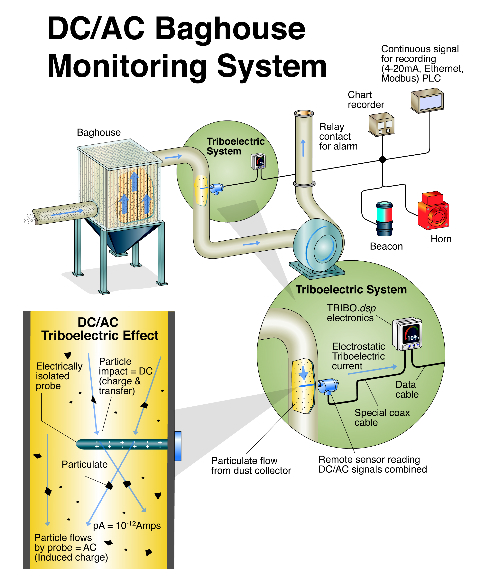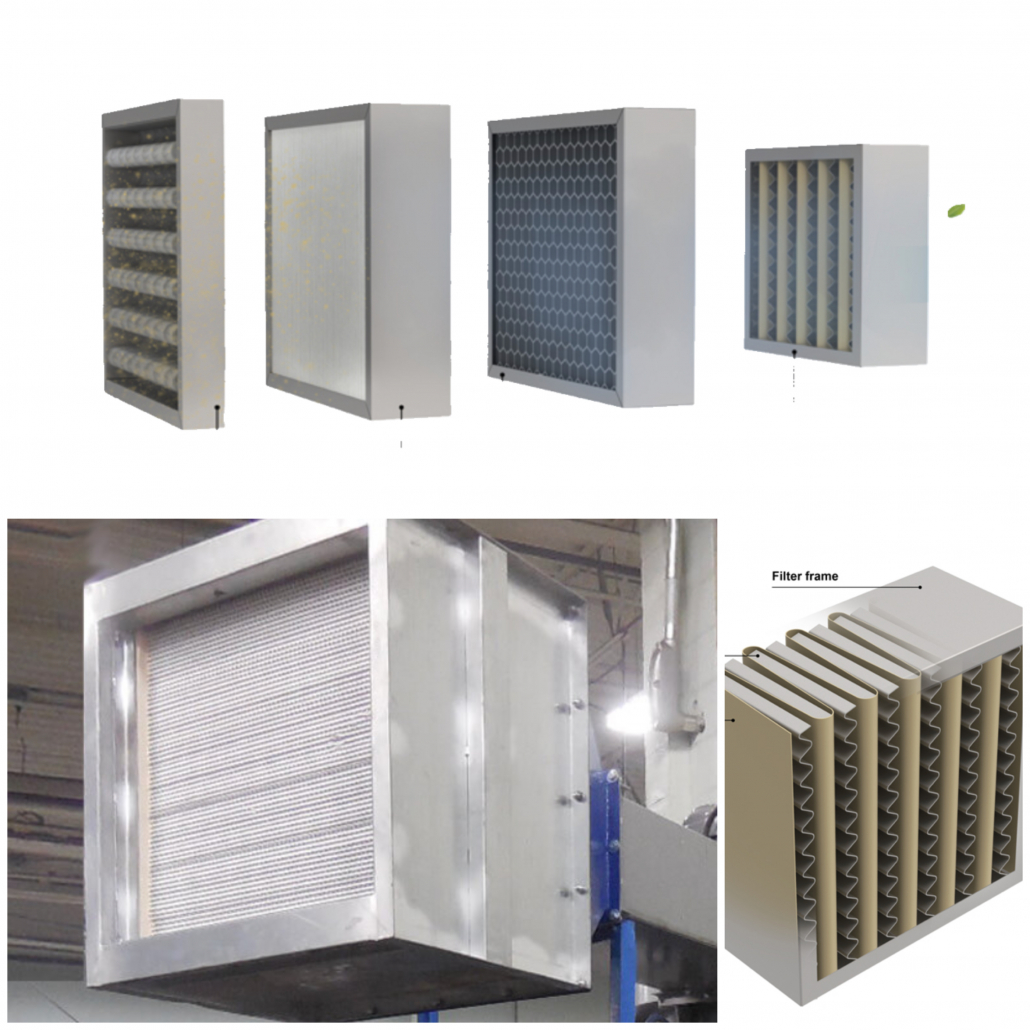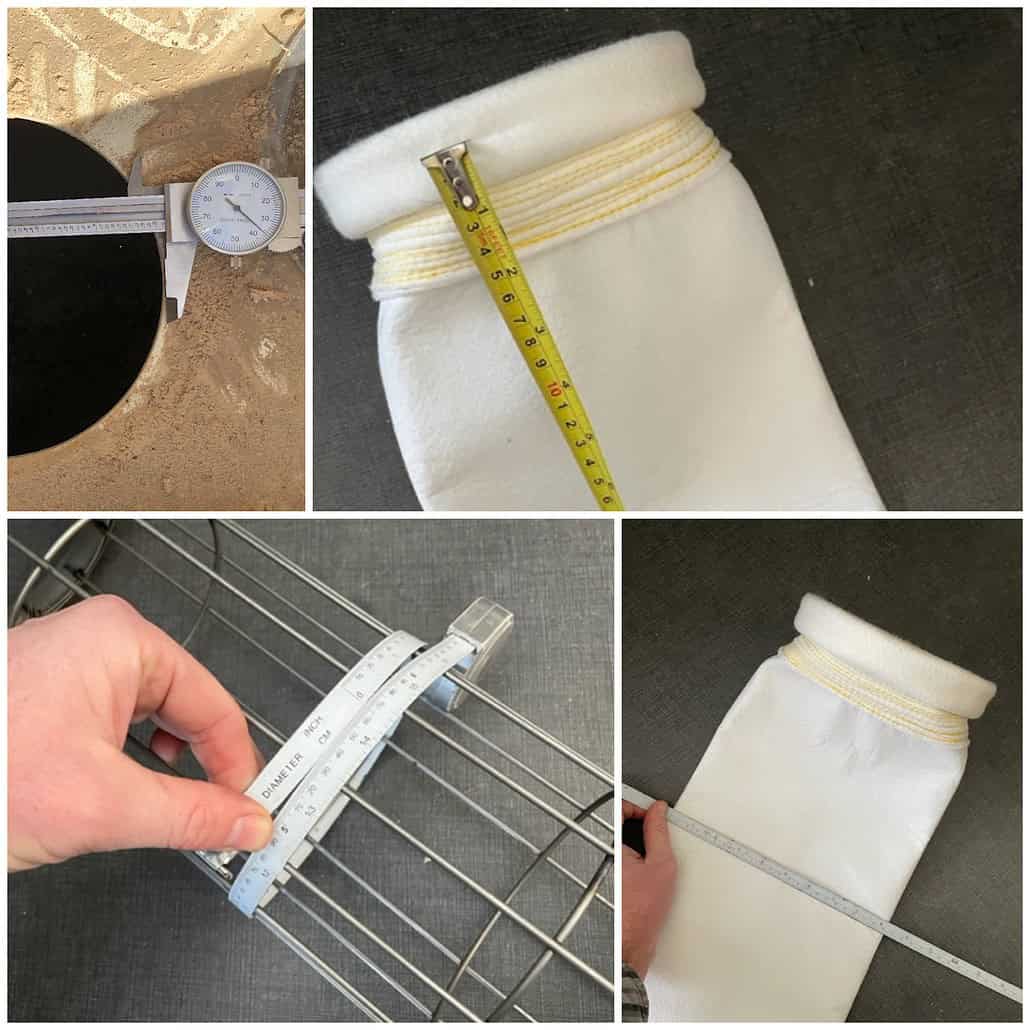By Dominick DalSanto
Baghouse.com
Quickly finding and replacing leaking filters is crucial for keeping a baghouse operating at peak efficiency. The longer you take to replace the leaking filter the more likely you will have to report the event to your air quality control regulatory agency (reportable event) and the more abatement costs you will incur.
How Broken Bag Detectors Work
Triboelectric broken bag detectors measure the amount of static electricity generated by dust particles in an airstream. Dust particles generate an electrical current when they encounter the insulated metal probe in the ductwork. A dust particle directly impacting the probe creates a DC signal while a particle passing near to the probe generates an AC signal. The latest generation of triboelectric detectors (such as the Auburn Systems’ TRIBO series) unify both signals and then output a measurement of particle concentration to a nearby control panel or transmit it to a PLC.
Using a Triboelectric Broken Bag Detector as Early Warning
Most leaking baghouse filters begin as small holes or rips that overtime become worse and worse. Catching a leak quickly is crucial. The longer a leak persists the worse it becomes, often quickly causing a plant to exceed its maximum PM 2.5 emissions limits set out in its air permit. Additionally, abatement requirements quickly increase as a leak continues over time.
Older optical emissions monitors (i.e. opacity meters) and optical bag leak detectors can only detect a filter leaking so badly damaged that the increase in emissions exceeds 10% opacity (often greater than the maximum permissible levels for many air permits).
Triboelectric systems are sensitive enough to detect even the smallest of increases in dust emissions such as when a bag first begins leaking. Operators can then examine the realtime trending emissions data to see whether it was a sudden spike indicates a damaged bag (such as from quickly worn hole) or slow rise indicating wearing filters.
Get a free quote today!
Using Broken Bag Detector to Pinpoint Which Filters Are Leaking
An added advantage of triboelectric bag leak detectors is they can enable operators and maintenance technicians to pinpoint exactly which bags are leaking and need to be replaced.
Personnel should carefully monitoring emissions while cleaning system runs. When emissions spike during one cleaning cycle it means that leaking filters are present. Using this method, maintenance personnel can trace the leaking filters down to a specific baghouse, compartment and even row (pulse jet only) of bags. This saves time and money over traditional dye leak testing.
However, on older units, or when first beginning to troubleshoot a unit dye leak testing should still form part of your maintenance schedule. Dye leak testing can pinpoint multiple leaks at once, and in structural components as well as filters.
By quickly pinpointing leaking filters maintenance staff also reduce the amount of abatement required after the leak is fixed.
Below is the sample data from a test conducted to determine the differences in performance between a triboelectric leak detection system and a typical optical system (opacity meter). Notice the huge difference in response time and abatement required.
| Leak Test Results | Triboelectric Bag Leak Detector | Optical System |
|---|---|---|
| Estimated Time to: | ||
| Detect Leak | Less than 1 Hour | 2-3 days |
| Locate Leaking Filter(s) | Less than 1 Minute | 2-3 Man Hours (dye leak test) |
| Clean Up Leak | Less than 1 Man-Hour | 8-10 Man Hours |
| Estimated Size of: | ||
| Hole Detected | 1/4” | 8” |
| Dust Accumulation | 2.6 cubic feet | 60 cubic feet |
| Dust Clean Up Tool | Shopvac | Shovels |
Source: https://cdn2.hubspot.net/hubfs/354686/BrandBuilder%20Solutions/Case%20Studies/Aluminum_Case_Study.pdf
Reduce Baghouse System Downtime
When a baghouse goes down it often brings much down with it, from specific equipment to entire production lines to even entire plants due to emissions or health and safety issues. Preventing unscheduled baghouse shutdowns directly impacts the bottom line. In some facilities, losses from just one down day can add up to tens of thousands of dollars in lost production, fines and other costs. Therefore, investing in the maintenance and upkeep of these baghouse systems is well worth the initial capital costs.
Triboelectric dust monitoring system often prove one of the most cost-effect ways to improve dust collector maintenance and operation. With the ability to monitor emissions in realtime and trends over time, operators can better assess the condition and operation of their baghouses than those who rely solely on differential pressure.
For example, by carefully analyzing the triboelectric data trends maintenance planners can accurately predict when filters will no longer achieve their require collection efficiency and need a changeout. Further, they can begin preparations for the changeout in advance, sourcing filters and cages, obtaining contract labor for the changeout and scheduling the changeout for the next most convenient time (e.g. yearly maintenance shutdown). Compare this with the added costs and stress involved when a changeout is done at the last minute!
Additionally, as mentioned above, triboelectric bag leak detectors also prevent downtime by quickly alerting plant personnel to any leaks as soon as they begin to form. By catching leaks before they become serious plants can avoid stoppages for abatement, repair and any possible fines or sanctions from air quality regulators.
Recap of the Key Points
- Triboelectric bag leak detectors directly impact the bottom line of your baghouse by improving maintenance efficiency, reducing downtime
- Increased detection range means finding leaks quicker, before they become reportable events
- See when filters first begin to fail allows predictive maintenance planning to reduce inconvenient shutdowns
- Find leaking filter bags quicker, pinpoint down to specific unit, compartment and row without a dye leak test
- Comply with MACT standards that require triboelectric broken bag detectors over opacity meters
Interested in a Triboelectric Broken Bag Detection System?
If you would like to know more about our line of triboelectric broken bag detectors and how they can benefit your facility contact us today for a free consultation and quote!







